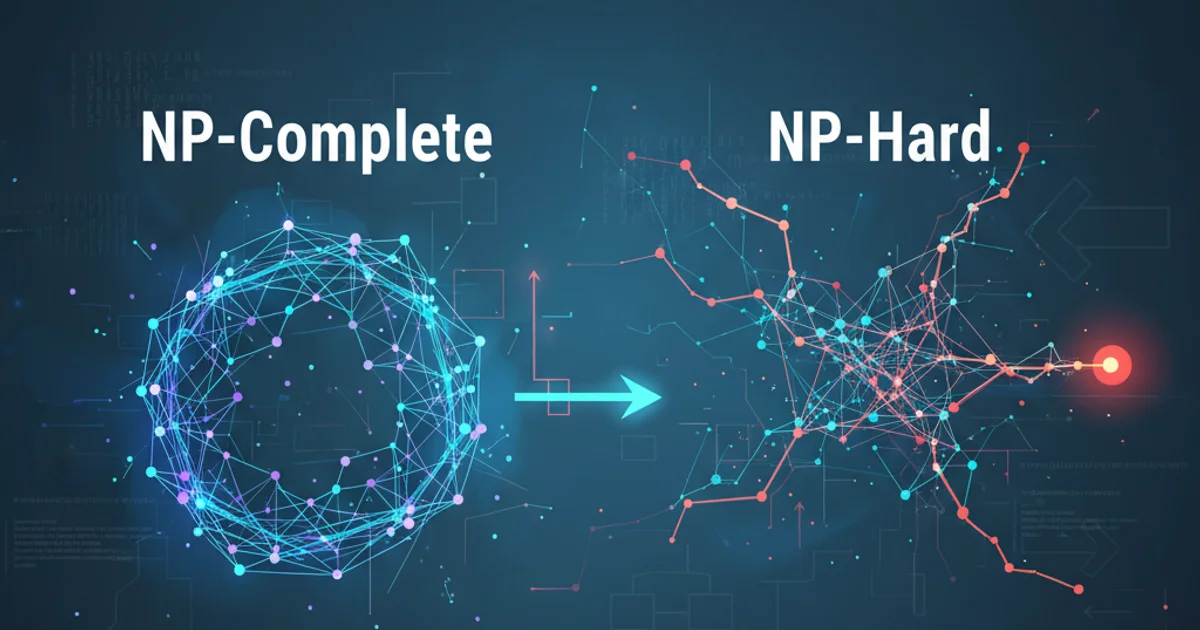NP-Complete VS NP-Hard
Categories:
NP-Complete vs. NP-Hard: Understanding Computational Complexity

Delve into the fundamental concepts of NP-Complete and NP-Hard problems, crucial for understanding the limits of efficient computation in computer science.
In the realm of computer science and algorithm design, understanding the computational complexity of problems is paramount. Two terms frequently encountered are NP-Complete and NP-Hard. While often used interchangeably by newcomers, they represent distinct, though related, classes of problems that define the boundaries of what can be efficiently solved by algorithms. This article will demystify these concepts, explain their significance, and illustrate their relationships.
What is 'P' and 'NP'?
Before diving into NP-Complete and NP-Hard, it's essential to grasp the foundational classes 'P' and 'NP'.
P (Polynomial Time): This class includes decision problems that can be solved by a deterministic Turing machine in polynomial time. In simpler terms, if a problem is in P, there exists an algorithm that can find a solution in a time proportional to a polynomial function of the input size (e.g., O(n), O(n log n), O(n^2)). Problems in P are generally considered 'efficiently solvable'. Examples include sorting, searching, and finding the shortest path in a graph.
NP (Nondeterministic Polynomial Time): This class includes decision problems for which a given solution can be verified in polynomial time by a deterministic Turing machine. It's important to note that 'NP' does not mean 'non-polynomial'. Instead, it refers to problems where if you are given a potential solution, you can quickly check if it's correct. The challenge is often finding that solution efficiently. Many problems in NP are not known to be in P, leading to the famous P vs. NP problem.
graph TD
A["Problem Class P"]
B["Problem Class NP"]
C["NP-Complete"]
D["NP-Hard"]
A --> B
C --> B
D --> B
C --> D
subgraph "Efficiently Solvable"
A
end
subgraph "Verifiable in Polynomial Time"
B
end
style A fill:#bbf,stroke:#333,stroke-width:2px
style B fill:#fbc,stroke:#333,stroke-width:2px
style C fill:#f99,stroke:#333,stroke-width:2px
style D fill:#f66,stroke:#333,stroke-width:2pxRelationship between P, NP, NP-Complete, and NP-Hard problem classes.
Understanding NP-Hard Problems
A problem is NP-Hard if every problem in NP can be reduced to it in polynomial time. What does 'reduced' mean here? It means that if you had an efficient (polynomial-time) algorithm to solve the NP-Hard problem, you could use it as a subroutine to solve any problem in NP efficiently. Essentially, NP-Hard problems are 'at least as hard as' any problem in NP.
Key characteristics of NP-Hard problems:
- They do not necessarily have to be decision problems (i.e., they can be optimization or search problems).
- They are not necessarily in NP themselves. An NP-Hard problem might not even have a solution that can be verified in polynomial time.
- If you find a polynomial-time algorithm for an NP-Hard problem, then P = NP (a major unsolved problem in computer science).
Understanding NP-Complete Problems
A problem is NP-Complete if it satisfies two conditions:
- It is in NP (meaning a given solution can be verified in polynomial time).
- It is NP-Hard (meaning every problem in NP can be reduced to it in polynomial time).
NP-Complete problems are the 'hardest' problems in NP. If you can find a polynomial-time algorithm for any NP-Complete problem, then you can solve all problems in NP in polynomial time, which would imply P = NP. This is why NP-Complete problems are so significant: they are the central problems whose efficient solvability would resolve one of the greatest open questions in theoretical computer science.
Famous examples of NP-Complete problems include:
- Satisfiability Problem (SAT): Given a Boolean formula, is there an assignment of truth values to its variables that makes the formula true?
- Traveling Salesperson Problem (TSP) (decision version): Given a list of cities and the distances between each pair of cities, and a distance limit, is there a route that visits each city exactly once and returns to the origin city, with a total distance less than or equal to the limit?
- Clique Problem: Given a graph G and an integer k, does G contain a clique of size at least k?
- Subset Sum Problem: Given a set of integers and a target sum, is there a subset of the integers that sums to exactly the target?
flowchart LR
subgraph "Problem Classes"
P["P (Polynomial Time)"]
NP["NP (Nondeterministic Polynomial Time)"]
NPC["NP-Complete"]
NPH["NP-Hard"]
end
P --> NP
NPC --> NP
NPC --> NPH
style P fill:#e0ffe0,stroke:#3c3,stroke-width:2px
style NP fill:#ffe0e0,stroke:#c33,stroke-width:2px
style NPC fill:#ffc0c0,stroke:#a00,stroke-width:2px
style NPH fill:#ff8080,stroke:#800,stroke-width:2px
click P "https://en.wikipedia.org/wiki/P_(complexity_class)" "P Class"
click NP "https://en.wikipedia.org/wiki/NP_(complexity_class)" "NP Class"
click NPC "https://en.wikipedia.org/wiki/NP-complete" "NP-Complete Class"
click NPH "https://en.wikipedia.org/wiki/NP-hard" "NP-Hard Class"Visualizing the relationships and hierarchy of P, NP, NP-Complete, and NP-Hard problem classes.
Practical Implications for Algorithm Design
When faced with a computational problem, understanding its complexity class has significant practical implications:
If a problem is in P: You can likely find an efficient algorithm to solve it. Focus on optimizing constant factors or finding simpler polynomial-time solutions.
If a problem is NP-Complete or NP-Hard: It's highly unlikely that a polynomial-time algorithm exists. Instead of searching for a perfect, efficient solution, your efforts should shift towards:
- Approximation Algorithms: Algorithms that find a solution that is provably close to the optimal solution within a certain factor.
- Heuristics: Algorithms that find good, but not necessarily optimal, solutions in a reasonable amount of time. These often rely on domain-specific knowledge.
- Exponential-Time Algorithms: For small input sizes, an exponential-time algorithm might be acceptable.
- Parameterized Complexity: Identifying parameters that, when small, allow for efficient solutions.
- Restricting the Problem: Solving a specific, simpler instance of the problem (e.g., TSP on a planar graph).
Recognizing these problem classes helps manage expectations and guides the choice of algorithmic strategies.